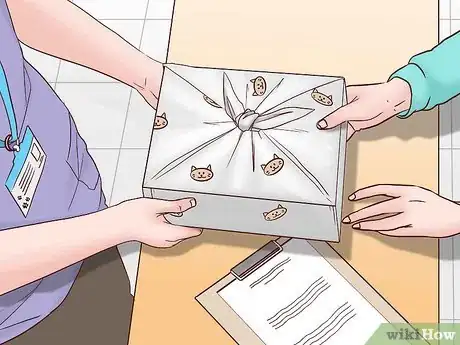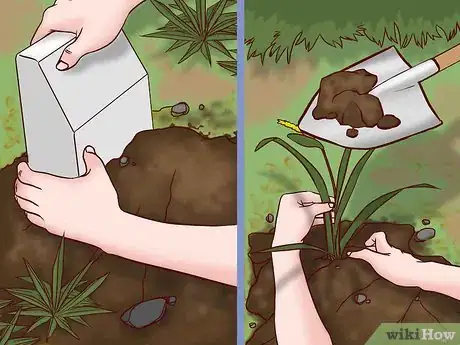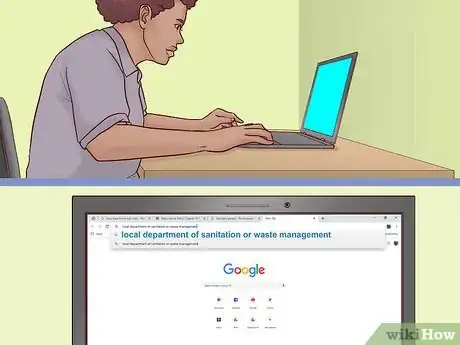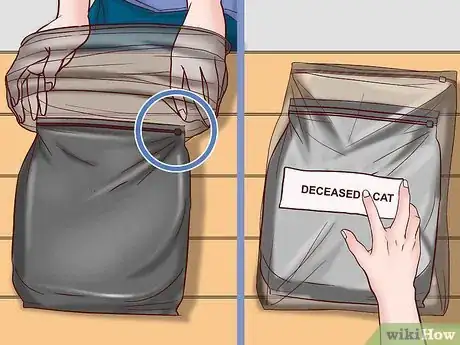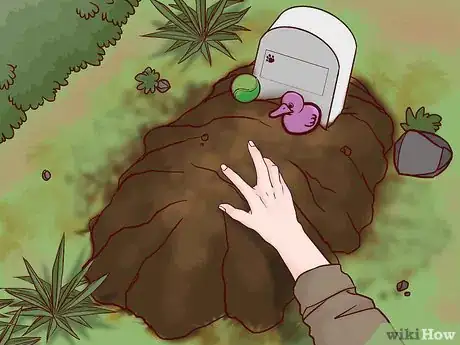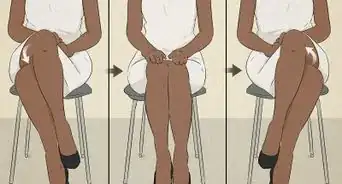This article was co-authored by Pippa Elliott, MRCVS. Dr. Elliott, BVMS, MRCVS is a veterinarian with over 30 years of experience in veterinary surgery and companion animal practice. She graduated from the University of Glasgow in 1987 with a degree in veterinary medicine and surgery. She has worked at the same animal clinic in her hometown for over 20 years.
There are 9 references cited in this article, which can be found at the bottom of the page.
This article has been viewed 17,973 times.
If you’re saying goodbye to your pet cat, deciding what to do with its remains isn't easy. Memorializing your pet, however, can help get you through the grieving process. The most popular options are cremation and burial, and each have their pros and cons. Cremation, for instance, is convenient, but it can be a lot more expensive than burial. If, on the other hand, you’ve found a deceased stray or feral cat, check online to find the right disposal procedures for your location.
Steps
Having Your Cat Cremated
-
1Choose cremation if you move often or burial is otherwise impractical. Cremate your cat if you expect to move in the near future and don’t want to leave behind its remains in a burial site. Cremation is also your best option if you don’t own private property. In many locations, it’s only legal to bury a pet in land that you own.[1]
- Ask your cat’s vet any questions you have about the cremation facility and how your pet’s remains will be treated, especially if you have concerns about getting the right ashes.
- If your pet was put to sleep, cremation eliminates the risk of exposing chemicals to the environment. The substances used to euthanize animals can be harmful to the water table.[2]
- Additionally, if your pet passed away due to an infectious disease, cremation can help prevent the illness from spreading. Burying it could threaten pets and other animals in the area.
-
2Bring your deceased cat to the vet promptly if it passed at home. If your cat passed at the vet office, the staff can make all the arrangements necessary for cremation. On the other hand, if it passed at home, call the vet, place your deceased cat in a bag or container for transport, and take it to the office as soon as possible.[3]
- If you need to store your deceased cat for any reason, place it in a tightly sealed bag and keep it in a cooler, refrigerator, or freezer. Note that you shouldn’t freeze it if you’ve asked the vet to perform a necropsy (autopsy).
- If your cat is sick and you are worried it might die soon or that it will need euthanasia, talk with your cat’s vet ahead of time about disposal of the remains. It will help to have this plan in place ahead of time since you will likely be distressed later on.
Variation: Vets typically guide pet owners through the process and provide information on the services offered by the crematorium, including available caskets, but you could also work directly with a cremation service. Some crematories offer pick-up and delivery services. Ask a vet, friend, or relative to recommend a reputable service, and contact them to make arrangements.
Advertisement -
3Ask for an individual cremation if you want a private memorial. Go with individual cremation if you want your cat’s remains returned to you. While it’s more expensive, pets are cremated separately so their owners can keep their ashes.[4]
- If honoring your pet is important, some crematories allow pet owners to visit the facilities to help verify that remains are handled with dignity.[5]
- You may want to look into a getting a scatter box of your cat’s ashes. This is often an inexpensive option and you can scatter the ashes in a place that your cat loved to spend time.
-
4Discuss communal cremation if you need the most practical option. If individual cremation isn’t affordable or desired, tell the vet or crematory you’re going with communal cremation. Just keep in mind your cat’s remains will not be returned to you. If you’re concerned about what happens to remains, check with the crematorium.[6]
- Communal cremation is generally a fraction of the cost of individual cremation.
- Typically, remains are buried at a specially licensed site after cremation.
-
5Fill out any required forms and pay the fee. After you’ve made your decision, you’ll be asked to fill out a cremation authorization form. You’ll enter information including your name and contact information, whether you want individual or communal cremation, and whether you want your pet’s ashes returned to you.[7]
- Finally, you’ll pay the fee, which depends on the type of cremation and whether any additional products and services are included (such as delivery or an urn). Individual cremations for cats are usually between $100 and $200 (U.S.), while communal are often in the $20 to $50 range.[8]
- If you opted for individual cremation, the time it takes to receive your cat’s remains will vary by the crematorium, but you will likely need to wait at least 1 week. Either pick them up at the vet’s office or have the crematorium deliver them to your home.
Burying Your Cat
-
1Check your local regulations on burying deceased pets. Burying a pet is legal in most areas, but there may be some restrictions. For starters, you may required to own the land or get permission from your landlord. Additionally, factor in how long you expect to stay in your home and whether you’re okay with leaving your pet’s remains if you move.[9]
- If your cat passed away due to an infectious disease, remember that burial isn’t the best option. You wouldn’t want to expose pets or other animals to the disease.
-
2Choose a meaningful spot for the burial site. Go with a site away from foot traffic that won’t be stepped on or disturbed. A good option could be spot where your cat loved to lounge.[10]
- Be sure that the location is safe and complies with local regulations. For instance, it may need to be at least 9 feet (2.7 m) away from water sources, cables, and pipes.
Tip: Place your deceased pet in a vessel before burial to help protect it from scavenging animals.
-
3Dig a hole that’s at least 3 feet (0.91 m) deep. Use a shovel to dig the hole; wetting the ground slightly then allowing it to dry a bit can help make digging easier. A depth of 3 feet (0.91 m) should work but, if you’re burying your cat in a vessel, the hole may need to be deeper.[11]
- To memorialize your cat, you could place its favorite toys or other meaningful objects in the burial site.
- Keep in mind that some wild animals will dig down to scavenge a buried pet. If you have wild animals in your area, then it might be better to have your cat cremated.
-
4Place a grave marker or plant at the site. After filling the hole with dirt, you could set a stone over the site with your cat’s name written or engraved on it. You could also plant flowers, seeds, or a tree sapling to help commemorate your pet.[12]
- For instance, if your cat always tried to get into a specific plant or flower, you could mark its grave with seeds or seedlings of that species.
-
5Look for a local pet cemetery if home burial isn’t an option. Search online for a local pet cemetery if you can’t bury your cat at home and don’t want to cremate it. While this service is often deeply personal, it can be expensive. Additionally, it’s most practical to make arrangements with a pet cemetery in advance instead of after your cat has passed.[13]
- A pet cemetery could also be a good option if you expect to move but want to be able to regularly visit your cat’s burial site.
- Expenses include the cost of the plot, annual maintenance and rental fees, and a coffin.
Disposing of a Deceased Stray Cat
-
1Look up your local laws on deceased animal collection. Disposal procedures vary by location, so double check how your jurisdiction handles deceased animals. Try searching online for the website of your local department of sanitation or waste management.[14]
- Depending on your location, you'll either call for a special pick-up or put it in your garbage receptacle for standard collection. You may also be required to bring it to a landfill or bury it yourself.
- Another option is to contact your local veterinary clinic and allow them to arrange for disposal of the cat.
- Call animal control if you suspect the cat had rabies or another infectious disease.
-
2Call your non-emergency line if the cat is on public property. If your city offers scheduled pick-ups, find the correct number to call on the waste management or sanitation department website. In the U.S., you typically call a non-emergency municipal services line, such as 3-1-1, to schedule a pick-up.[15]
- While some jurisdictions offer scheduled pick-ups, they may only do so if the deceased cat is on public property. If the cat is on a public sidewalk or street, you’ll probably only need to tell the operator its location.
- If the cat is on your private property, properly disposing of it may be your responsibility.
-
3Seal the cat in a bag if the sanitation department will collect it. If your jurisdiction allows small animals to be placed in standard garbage bins, first place the cat in a heavy-duty plastic bag. Seal the bag and, for best results, double bag it. You may also be required to label the bag “dead cat” or “deceased cat.”[16]
- To avoid coming into direct contact with the animal, turn the bag inside out, use it to scoop up the remains, then turn it right-side out again. It’s like the technique you’d use to pick up after a dog when it goes potty.
- Do not put an animal in the trash if you suspect it had rabies or another infectious disease. Instead, call animal control or emergency services.
Safety Tip: Wear disposable gloves when you handle the cat, and wash your hands thoroughly with soap and hot water when you’re finished.
-
4Bury the deceased cat if you’re required to or want to honor it. If you’re not thrilled about putting a feral or stray cat in the garbage, bury it as you would a pet. Additionally, if your local sanitation department doesn’t dispose of deceased animals, they may require you to bury it on your own.[17]
- Bury the cat in a hole that’s at least 3 feet (0.91 m) deep, and make sure the site is 9 feet (2.7 m) away from water sources, cables, and pipes.
Warnings
- Remember to practice healthy hygiene when handling a deceased animal. Wear gloves, avoid coming into direct contact with the remains, and wash your hands thoroughly when you’re finished.⧼thumbs_response⧽
References
- ↑ https://www.cats.org.uk/uploads/documents/CP_-_After_death.pdf
- ↑ http://www.vetstreet.com/our-pet-experts/pet-cremation-101-what-you-need-to-know-to-make-an-informed-decision
- ↑ https://www.aspca.org/pet-care/general-pet-care/end-life-care
- ↑ https://yourspca.org/what-we-do/euthanasia-services/
- ↑ https://www.cats.org.uk/uploads/documents/CP_-_After_death.pdf
- ↑ https://www.cats.org.uk/uploads/documents/CP_-_After_death.pdf
- ↑ https://www.avma.org/KB/Policies/Documents/model-euth-auth-form.pdf
- ↑ https://yourspca.org/what-we-do/euthanasia-services/
- ↑ https://www.aspca.org/pet-care/general-pet-care/end-life-care
- ↑ https://www.cats.org.uk/uploads/documents/CP_-_After_death.pdf
- ↑ https://icatcare.org/advice/general-care/cats-and-you/final-resting-place-your-cat
- ↑ https://www.cats.org.uk/uploads/documents/CP_-_After_death.pdf
- ↑ https://www.aspca.org/pet-care/general-pet-care/end-life-care
- ↑ https://www1.nyc.gov/nyc-resources/service/1487/dead-animal
- ↑ https://www.houstontx.gov/solidwaste/deadanimal.html
- ↑ https://www1.nyc.gov/nyc-resources/service/1487/dead-animal
- ↑ https://apps.leg.wa.gov/WAC/default.aspx?cite=246-203-121

